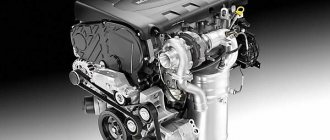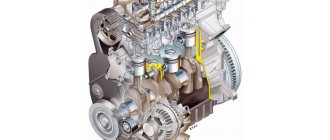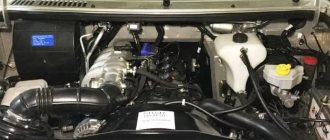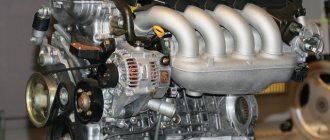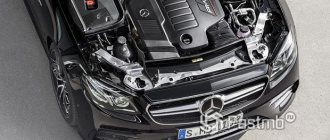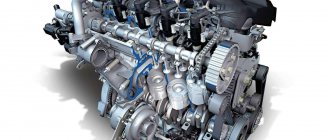History of the Toyota 1G-E engine
In 1979, Toyota released a series of 2-liter six-cylinder gasoline engines to replace the M-series engines.
This series of motors is assigned the index G. The differences between this series and other modifications are that:
- all subseries are of the same volume, as well as the timing belt drive;
- Motors with a twelve-valve system do not bend the valves when the timing mechanism drive breaks, unlike a sixteen-valve system.
- A new fuel system with electronic injection and various sensors such as air flow and oxygen has been installed.
When creating a new series, Toyota pursued several goals - to lighten the engine design and make it more economical. The series was created for a new generation of middle class cars.
This series of engines turned out to be very reliable and their service life with proper operation is at least 350,000 km. They have proven themselves to be low noise and transmit virtually no vibration, but are very picky about the quality of engine oil. Their main problem is the oil level sensor, which often fails. No further widespread problems were encountered.
The 1G-E engine was installed in commercial vehicles for Southeast Asia, had 2 valves per cylinder and was not an environmentally friendly engine.
Technical characteristics of the Toyota 1G-E engine
| Type of cylinder arrangement | in-line |
| Number of cylinders | six |
| Number of valves per cylinder | two |
| Piston stroke, mm | 75 |
| Piston diameter, mm | 75 |
| Compression ratio | 9.1 |
| Engine volume, cm3 | 1 988 |
| Engine power, l. s./about. min. | 109/5 000 |
| Torque, Nm/rev. min | 162/4 000 |
| Fuel, AI | 92 |
| Engine weight, kg | — |
| Fuel consumption, l/100 km | 6.1 |
| City | — |
| Route | — |
| Mixed cycle | — |
| Engine life, t. km | 350- |
| ICE potential in l. With. | — |
The engine number is located on the left side of the block in the direction of travel of the car, stamped on a special protrusion at the rear of the block.
Reliability, weaknesses and maintainability of the Toyota 1G-E engine
Since this engine model was not supplied to the European market and was used only in commercial vehicles, there is no information on weak points and maintainability. Most likely, like the entire G series, there was a problem with oil leakage from under the pressure sensor in the lubrication system. There is also no information on servicing this model. We would venture to assume that the oil recommended by Toyota from 5W30 to 10W30 is used depending on operating temperature conditions.
This motor was installed on MARK II 1986 and Crown GS130/131/136V/130G cars.
1G service regulations
The power units of the 1G series were unpretentious, did not require expensive oils and high quality fuel, systematic maintenance of these engines made them indestructible. All the owner had to do was perform the simplest steps described in the manual. The correct selection of oil and its timely replacement are important; the filter element must also be replaced at each oil change.
Thus, the maintenance of this engine should be like this:
- Change the oil every 7,000-10,000 kilometers, as well as install a new filter;
- The drive belts of attachments are checked every 30 thousand km; they should be replaced after 10,000 km. mileage;
- Every 10,000 km. the condition of the cooling system should be checked, the pump life is about 50 thousand km, and the antifreeze should be changed every 3 years;
- It is recommended to change the air and fuel filters after every 20,000 kilometers, otherwise on engines equipped with superchargers there may be irreversible consequences due to driving on a lean mixture;
- Every 30 thousand kilometers it is recommended to adjust the valves; they are adjusted by replacing the washers in the pushers; hydraulic compensators are not provided in these power plants; in the 1G-FE BEAMS engine, valve adjustment is carried out by replacing the pushers;
- Spark plugs require replacement after 30-50 thousand kilometers, depending on the modification; it is worth understanding that untimely replacement can kill the ignition coils on 1G-GZE and 1G-FE BEAMS engines;
- The timing belt should be changed every 100,000 km. mileage, on the 1G-FE BEAMS engine, its condition should be monitored more often, since this power plant bends the valves when the belt breaks, but in general, 1G series engines do not bend valves when the timing belt breaks or jumps.
Replacing timing belt 1G-FE BEAMS
Review of faults and repair methods
Power plants of the 1G series do not cause any special problems to the owner; basically, all malfunctions appear due to untimely maintenance and wear.
- Oil burns can be observed after 200,000 km. mileage, the culprit is very often the oil seals, in 90% of cases they just need to be replaced and the oil burn will disappear, but if this does not help, then the oil scraper rings are stuck, decarbonization helps some instances, but most often an engine overhaul is required
- Poor engine starting in the cold season is caused by pinched valves, it can be treated by regular valve adjustment, very often in cold weather the engine does not start due to a non-working cold start injector, it was installed on early versions of the 1G engine, in this case the cold start injector thermostat will need to be replaced, many car enthusiasts force the injector to turn on;
- A low oil pressure alarm is almost always associated with a malfunction of the oil pressure sensor, but if replacing the sensor does not help, then the oil pump and bearings should be inspected;
- Unstability of idle speed is due to problems with the idle speed sensor, cleaning or replacing the sensor helps, also on the 1G-FE BEAMS engine this may also be due to the VVT-i system, if it fails, then floating speed and decreased engine power will cause you provided for;
- Also, the throttle position sensor often fails, then you get a cutoff at certain speeds, increased fuel consumption and starting problems;
- The oil pump seal often leaks, this entails the rapid death of the timing belt, this is not so bad on almost all 1G series engines, but the 1G-FE BEAMS engine bends the valve and if the timing belt breaks on it, the consequences will be irreversible, so it’s worth keeping an eye on for engine dryness in the timing belt area
- On engines equipped with superchargers, one of the diseases is a breakdown of the cylinder head gasket, there is only one way out, replacing the gasket with the original, analogues do not last long.
History of the Toyota 1G-EU engine
In 1979, Toyota released this model for rear- and all-wheel drive vehicles. This series had a twelve-valve and single-camshaft engine, as well as an electronic fuel injection system and hydraulic compensators. The peak of popularity occurred in the second half of the 80s and it was produced until 1988.
Technical characteristics of the Toyota 1G-EU engine
| Type of cylinder arrangement | in-line |
| Number of cylinders | six |
| Number of valves per cylinder | two |
| Piston stroke, mm | 75 |
| Piston diameter, mm | 75 |
| Compression ratio | 9.2 |
| Engine volume, cm3 | 1 988 |
| Engine power, l. s./about. min. | 105-130/5 000 |
| Torque, Nm/rev. min | 157-172/4 000 — 4 400 |
| Fuel, AI | 92,95 |
| Engine weight, kg | — |
| Fuel consumption, l/100 km | |
| City | 11.6 |
| Route | 5.6 |
| Mixed cycle | — |
| Engine life, t. km | 350- |
| ICE potential in l. With. | — |
Reliability, weaknesses and maintainability of the Toyota 1G-EU engine
1G-EU is a very reliable engine group. Like the entire series, they have quiet and virtually vibration-free operation, but they are very picky about the quality of oil and fuel. Poor quality oil can cause failure of hydraulic compensators and oil starvation in the cylinder head.
There is another problem - its length. Because of this, the oil pan often jams due to uneven roads, which again leads to oil starvation. The engine is repairable, it can easily be bored to repair dimensions, both the piston group and the crank mechanism.
When the timing belt breaks, there is no “friendly” meeting between the valves and the pistons. The recommended oil by the manufacturer is 5W30 and the service volume is 4.2 liters.
Among owners of cars with such engines, there are often swap projects based on 1G-GTE, 1G-FE Beams, 1G-GE. The cost of these “transformations” starts from 100,000 rubles and above. It all depends on the imagination of the car owner.
The engine of this series was installed on Crown GS 110 and 120 bodies, MARK II/CHASER/CRESTA GX 110 and 120 bodies, SOARER GZ 10 and 20.
Tuning
8 valve Lada Kalina engine characteristics, dynamics, fuel consumption. Lada Kalina 2 which engine is better
To increase engine power, reduce the pulley mounted on the supercharger (or on the engine). Due to this, it is possible to increase the compressor speed and increase the boost pressure by 0.1-0.2 bar. When changing the diameter of the pulley, it is necessary to use a belt with a suitable length; the part is selected using the selection method. It is also necessary to adjust the bypass valve that regulates the inlet pressure. An air filter with reduced resistance is installed in parallel. Refinement allows you to get power up to 200 hp. With.
Further increase in engine power requires expensive modifications associated with the installation of another piston group and turbocharger. It is more advisable to install an engine of a different model on the car, which has a larger volume and power. A number of GZE engine components are used to modify cars of other brands.
The owner of a Toyota Crown with a 1G-GZE engine talks about the features of operating the car, including looking under the hood and explaining interesting and useful nuances.
History of the Toyota 1G-GEU engine
1G-GEU is the very first Toyota engine on which two camshafts and four valves were installed for each cylinder. For which he received a medal from the Japanese Society of Engineers and Mechanics (JSME).
It was created by the company in 1982, was produced for only 4 years and was installed on cars intended for the Japanese domestic market. In 1983, a fuel system was installed, which, using a pressure sensor in the intake manifold, determined the necessary parameters for the air-fuel mixture.
Technical characteristics of the Toyota 1G-GEU engine
| Type of cylinder arrangement | in-line |
| Number of cylinders | six |
| Number of valves per cylinder | four |
| Piston stroke, mm | 75 |
| Piston diameter, mm | 75 |
| Compression ratio | 10.0 |
| Engine volume, cm3 | 1 988 |
| Engine power, l. s./about. min. | 160/6 200 |
| Torque, Nm/rev. min | 181/5 600 |
| Fuel, AI | 92,95 |
| Engine weight, kg | — |
| Fuel consumption, l/100 km | |
| City | 11.2 |
| Route | 5.8 |
| Mixed cycle | — |
| Engine life, t. km | 350- |
| ICE potential in l. With. | — |
The internal combustion engine number is located, as on all G series engines, on the left side at the rear of the block on a special ebb.
Reliability, weaknesses and maintainability of the Toyota 1G-GEU engine
Maintainability is the same as any G series; it can be sharpened, polished and repaired without any problems or strains. The only disadvantage for this series is that when the timing belt breaks, the valves bend against the engine pistons.
Swap 1G-GEU can be easily changed to 1JZ, 1G-GTE, 1G-GZE, 1G-GE. The question is what the owner wants from the car and his financial capabilities.
This series was installed on:
- Celica XX GA61 from 1982-1985;
- Chaser/Mark II/Cresta 1982-1986;
- Crown 1983-1986;
- Soarer 1983-1986.
Review: An average engine with good torque is quite suitable for a novice drifter.
Malfunctions and repairs of the 1JZ-FSE/GE/GTE engine
Among all Toyota engines, the JZ series has become one of the most famous, perhaps even the most famous, largely due to its incredible penchant for tuning, but let's start from the beginning. The JZ family included two engines, the first had a displacement of 2.5 liters and was called 1JZ, the second 3 liters. — 2JZ. Let's talk about the first representative, the successor to the 1G engine and the main competitor of the RB25 - it is an in-line six, in a cast-iron cylinder block, two-shaft, with 4 valves per cylinder, the timing drive is belt driven (the belt is replaced every 100 thousand km, and in in case of a break, the 1JZ valve does not bend, except for the FSE version), the intake manifold has variable geometry ACIS, since 1996 the engine has been modified with a cylinder head, a VVTi variable valve timing system has appeared on the intake, the cooling system has been changed, and more. There are no hydraulic compensators on the 1JZ; valve adjustment is carried out, if necessary, once every 100 thousand km, using shims. Since 2003, the 1JZ-FSE has been replaced by the newer aluminum 4GR-FSE.
History of the Toyota 1G-GTEU engine
In 1986, Toyota introduced a modified 1G-GEU model to the engine market, with two turbines installed. It was the same inline six, but with the designation 1G-GTEU, installed on the Toyota Supra. With the help of turbines, the power was increased from 160 hp. With. up to 210 l. With. and increased torque. It existed for only two years and Toyota modified it into the 1G-GTE, changing its intercooler cooling system to a water one. And in 1991 they replaced it with a new series and model 1JZ-GE.
Technical characteristics of the Toyota 1G-GTEU engine
| Type of cylinder arrangement | in-line |
| Number of cylinders | six |
| Number of valves per cylinder | four |
| Piston stroke, mm | 75 |
| Piston diameter, mm | 75 |
| Compression ratio | 9.0 |
| Engine volume, cm3 | 1 988 |
| Engine power, l. s./about. min. | 210/6 200 |
| Torque, Nm/rev. min | 185/6 200 |
| Fuel, AI | 92,95 |
| Engine weight, kg | — |
| Fuel consumption, l/100 km | |
| City | 11.8 |
| Route | 5.6 |
| Mixed cycle | — |
| Engine life, t. km | 350 + |
| ICE potential in l. With. | 300 + |
Reliability, weaknesses and maintainability of the Toyota 1G-GTEU engine
Like the entire G series, the 1G-GTEU engine is picky about the quality of fuel and oil. Otherwise a reliable, repairable engine.
Engine tuning 1G-GTEU
The 1G-GTEU engine is the best model in this series for tuning. The piston diameter is bored to 78 mm, which increases the volume to 2,150 cm3 and increases the compression ratio to 9.1. Also, by replacing elements associated with the turbines, you can increase the power to 300 hp. With. For example: intercooler, pump, exhaust and brain. If you replace the piston, crankshaft, in general, with a deeper and more expensive tuning, you can achieve greater results.
A swap of this series is also possible and sometimes cheaper than the tuning process. This model is often replaced with 1G-GTE or 1JZ-GE, or younger engine series.
Review: it feels good on the handle, almost as good as the 1JZ.
Motor modifications
The 1G-FE motor has seven official modifications.
- The first - 1G-EU - is the first version of 1G engines with a single camshaft. Its compression ratio did not exceed 8.8, power was up to 125 hp. at 5400 rpm. Further changes initially led to an increase in the compression ratio and power to 140 hp, but later the power was again reduced to 105 hp. at the remaining 5400 rpm. They were installed on the model of the Cross, Mark.
- The second version of this engine, 1G-GEU, was distinguished by a cylinder head with 24 valves and an adjustable T-VIS exhaust manifold geometry. The modification brought with it an increase in power to 160 hp.
- The 1G-GTEU modification was a turbo version of the previous engine. With the compression ratio reduced to 8.5, two additional turbochargers were installed, which made it possible to achieve a power of 185 at 6200 rpm.
- 1G-GZEU/GZE - based on a fundamental change in the internal design. The SC-14 compressor was replaced by turbines. This made it possible to add electronic ignition.
- 1G-GE - became another modernization of the 1G-GEU, in which the mass air flow sensor was replaced by an absolute pressure sensor.
- 1G-GTE is an improved version of the 1G-GTEU turbo engine. Not installed on Toyota Crown models.
- And finally, the 1G-FE was the final improvement on the 1G-EU, featuring a 24-valve cylinder head. Power was 135/5600.
History of the Toyota 1G-GPE engine
In 1988, the 1G-GEU was replaced by the 1G-GE model and, at the same time, gas fuel equipment for running on propane was installed on this model and assigned the index 1G-GPE. To facilitate cold starts in winter, a heater was installed on the gearbox. This model was based on the 1G-FE series; with the help of Yamaha, the cylinder head was changed, which made it possible to increase the power of the internal combustion engine. This model was made for the Japanese domestic market and for the Crown comfort model.
Technical characteristics of the Toyota 1G-GPE engine
| Type of cylinder arrangement | in-line |
| Number of cylinders | six |
| Number of valves per cylinder | four |
| Piston stroke, mm | 75 |
| Piston diameter, mm | 75 |
| Compression ratio | 8.5 |
| Engine volume, cm3 | 1 988 |
| Engine power, l. s./about. min. | 110/5 600 |
| Torque, Nm/rev. min | 152/2 400 |
| Fuel, GAS | Propane |
| Engine weight, kg | — |
| Fuel consumption, l/100 km | |
| City | — |
| Route | — |
| Mixed cycle | — |
| Engine life, t. km | 350 + |
| ICE potential in l. With. | — |
Installed on one Toyota Crown Comfort car in a 130 body.
General review: old, but very reliable and unpretentious workers. Motors are easy to repair, but require timely maintenance. It's a shame they don't make engines like this anymore.
Description of the 1G FE motor device
Stock model
What is a contract engine? how to choose the right contract engine?
The first development of the G series, designated 1G EU, was a cast iron block with 6 cylinders arranged in a row and a head with 12 valves. The engine power reached 125 hp/5400, and torque - 160 Nm/4400. Subsequent improvements to the design helped enhance the characteristics and improve the operation of the systems. However, the engine displacement is 1988 cc. cm, cylinder size and piston stroke of 75 mm each remained unchanged for the entire line.
When developing the Toyota 1G FE, the plant was faced with the task of creating a compact, modern engine to replace the 1G EU. To do this, they used a narrow cylinder head, previously designed by Yamaha engineers, into which 24 valves fit: 2 inlets and 2 outlets per cylinder. The cylinder block was left cast iron.
The gas distribution mechanism was built according to the DOHC scheme with two camshafts. The intake shaft was driven by a toothed belt, the exhaust shaft by a Twincam gear. To adjust the thermal gap, pushers with adjusting washers were used. The timing belt also drove the water pump and was tensioned using rollers.
The 1G FE engine was controlled by an ECU. The injection injection system was equipped with a MAP sensor. The ignition system worked from a distributor, which received high voltage from a coil. The first model of the unit did not receive complex electronic devices.
Modernization
In 1996, a restyled version 1G FE was released. Engineers updated the control system and modified the injectors. As a result, it was possible to increase the engine power by 5 hp. With. The real update began in 1998, when it was necessary to create an uprated engine for the Altezza based on the existing stock.
As a result of the modernization of the 1G FE internal combustion engine with the BEAMS prefix, it turned into an independent unit that has little in common with the stock version. The design of the head, connecting rod and piston group, and injectors have changed. Now there were no grooves on the piston heads. To adjust the gaps, pushers with replaceable cups were installed.
- The intake system was equipped with a VVT-i variable valve timing system. Now, at 6000 rpm, the standard camshaft cam was replaced by a cam with a different profile, which made it possible to increase traction for confident acceleration;
- the throttle valve was replaced with electronic ETCS;
- the intake manifold has a variable geometry thanks to the installation of an ACIS electro-pneumatic valve;
- Contact ignition was replaced with DIS6 - “distributorless ignition system.” Now each cylinder had its own coil, which increased the accuracy and reliability of the system.
BEAMS has become more powerful, more economical and more environmentally friendly than its predecessor. The compression ratio was increased to 10 to 1. Environmental standards increased from Euro-2 to Euro-3.
Price of 1JZ GE engine new and contract
On the secondary market, the engine, with or without VVTi installed, can be found for the following price:
- 10,000 rubles if this motor can only be disassembled for spare parts;
- A decent used engine will cost 43 thousand rubles. Typically, such engines are checked by the manufacturer, and then by our experienced mechanics. And only then are they sold to car owners;
- A new engine will cost 65 thousand rubles.
1JZ GE engines installed in Toyota cars are considered indestructible. Therefore, when purchasing a 1JZ GE unit from the secondary market, you don’t have to worry about its serviceability.



